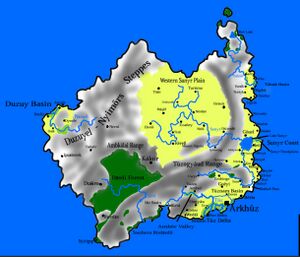Etzeá
This article is a construction site. This project is currently undergoing significant construction and/or revamp. By all means, take a look around, thank you. |
| Etzeá | |
|---|---|
| etzeá | |
| Pronunciation | [ed͡zeɑ] |
| Created by | Jukethatbox |
| Date | 2023 |
| Native to | Etzeán Island |
Yeldhic
| |
Early forms | Proto-Yeldhic
|
Standard form | Etzeá Standard
|
Dialects |
|
| Official status | |
Recognised minority language in | Moshurian Empire |
 Etzeán Island. Most Etzeá speakers live on the western side of the island, past the Tûzogyâud Range. | |
Etzeá(etzeá; [ed͡zeɑ]) is the secondary language spoken on the island of Etzeán within the Moshurian Empire. Due to its early geographic isolation from mainland Yeldhic languages, Etzeá became the closest modern living relative to Proto-Yeldhic in the Yeldhic language family, making the language a key contributor in modern reconstructions of Early Proto-Yeldhic. Since the arrival of the Taskaric Néekh people in the Tûznam Basin around 1350 UH, various Néekh loanwords and Taskaric language loanwords in general have seeped into the Etzeá lexicon, such as ungescu.
History
Etymology
The name etzeá's etymology is heavily debated, though one theory is that it developed agglutinatively by the combination of one word and a case marker: Proto-Yeldhic *eðu, "land" and ablative case marker *-ē, or in other words, *eðʷē, "away from the mainland".
Formation
The first Etzeic peoples were a Proto-Yeldhic people who probably inhabited Kokiso Point, the closest coastal landmark on Talkoch to Etzeán Island. They probably arrived on Etzeán Island around 2400 UH, just in time before the development of the Paleoyeldhic languages on the mainland in 2370 UH. On Etzeán Island, the Etzeic peoples spread all the way to the Tûzogyâud Range by 1750 UH. The areas around Mount Ogoñi was settled later, around 1600 UH.
Phonology
Consonants
| Labial | Alveolar | Post-alveolar | Palatal | Velar | ||
|---|---|---|---|---|---|---|
| Plosive | p b | t d | c ⟨ty⟩ ɟ ⟨dy⟩ | k g | ||
| Nasal | m | n | ɲ ⟨ñ⟩ | ŋ ⟨ng⟩ | ||
| Tap/trill | ɾ ⟨r⟩ · r | |||||
| Lateral approximants | l | ʎ ⟨ll⟩ | ||||
| Fricatives | pulmonic | s z | ʃ ⟨c⟩ ʒ ⟨j⟩ | ç ⟨ch⟩ | x ⟨h⟩ | |
| palatalised | sʲ ⟨ss⟩ zʲ ⟨zz⟩ | |||||
| Affricates | pfʷ ⟨ŵ⟩ | t͡s ⟨ts⟩ d͡z ⟨tz⟩ | (t͡ɕ) (d͡ʑ) | |||
| Semivowel | w | j ⟨y⟩ | ||||
⟨th⟩ is a digraph that was once used to represent Moshurian /ð/. Modern speakers pronounce ⟨th⟩ as /s/.
Vowels
| Front | Central | Back | |
|---|---|---|---|
| Close | i iː | u uː | |
| Close-mid | e eː | o oː | |
| Open-mid | ɛ | ɔ | |
| Open | a aː | ɑ |
/ɑ/, /ɛ/ and /ɔ/ are shown by the letters ⟨á⟩, ⟨é⟩ and ⟨ó⟩ respectively. Long vowels are represented by circumflexes, as in ⟨â, ê, î, ô, û⟩ for /aː eː iː oː uː/ respectively. All Proto-Yeldhic vowels, including long vowels, are preserved in Etzeá, except *é which merged with /e/.
